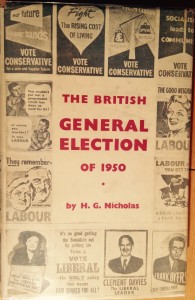The British General Election of 1950: full of interesting information for followers of contemporary politics
The British General Election of 1950 was at the time only the second in what has since become the essential Nuffield series of general election books, a series which is now a permanent part of following elections in the UK.
 Its age shows in some ways – not only of course in the subject matter but also in the very light touch of statistics (though they were advanced for the time). The electoral system back in 1950 was nominally the same as now, but its working were very different. Turnout was higher in Labour than Conservative seats and the bias in seats per votes worked in favour of the Tories, both a reverse of what we now see.
Its age shows in some ways – not only of course in the subject matter but also in the very light touch of statistics (though they were advanced for the time). The electoral system back in 1950 was nominally the same as now, but its working were very different. Turnout was higher in Labour than Conservative seats and the bias in seats per votes worked in favour of the Tories, both a reverse of what we now see.
Some things, however, do not change – as with the complaint that the 1950 election went past without the major issues being debated: “For all its admirable reasonableness and sobriety, its high poll and its low tempers, the election did not bring squarely before the public the crucial issues of the time … Foreign affairs was virtually excluded … and the problems of our balance of payments were seldom put in the forefront of discussion.”
To a modern campaigner’s eyes some of the events read surprisingly, but often with a contemporary echo, such as the stories of how the parties over-reacted to a change in the law controlling election expenses. It was meant to be just a tidying up exercise but resulted in many being worried it was more substantive with, for example, the Labour Party’s celebration of its creation being axed as a result.
Surprising too, given the ban on paid canvassing, is the account of how “Conservatives had undoubtedly put in more work on marking up their [electoral] registers, often with the assistance of paid canvassers (and canvassing “tutors”)”.
Canvassing was seen – at least in the eyes of the author – as a preferable tactic to “another device potentially more objectionable … because [it was] avowedly, and not just incidentally, an instrument of mass pressure”. This objectionable tactic? The humble window poster.
Certainly it’s easy to see how in closely knit communities pressure to put up a poster for the majority – or not to display a poster for the minority – can be unwelcome and unpleasant. There is also, however, a sense running through the book that the author is rather sniffy about politicians and politics, a perhaps surprisingly common trait amongst many who look to document both.
Even with that caveat, there’s much to savour and learn from in this book.
If you like this, you might also be interested in Margin of Victory: How Technologists Help Politicians Win Elections.
Got a view on this review? Then please rate it on Amazon.
Buy The British General Election of 1950 by H.G. Nicholas here.
Leave a Reply